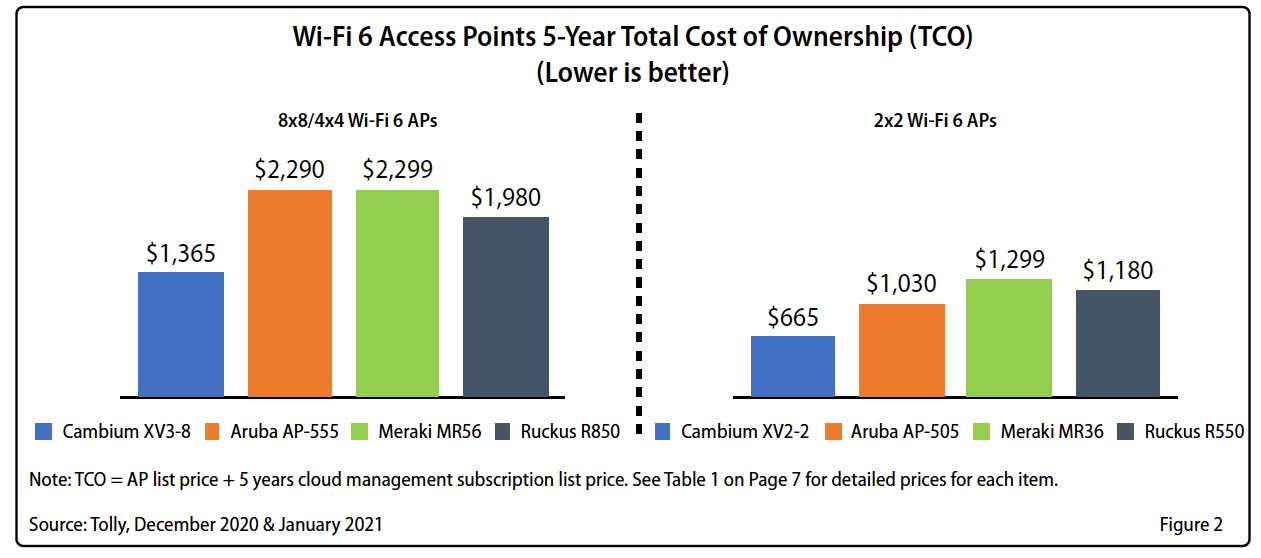Wi-Fi 6 brings WLAN performance to a new level with aggregate throughput potential measured in Gigabits per second. The advent of Wi-Fi 6 also brings economics to a new level as higher performance and higher density impact price-performance and total cost of ownership (TCO) calculations.
Cambium Networks commissioned Tolly to benchmark the performance of its tri-radio XV3-8 (8×8/4×4 MU-MIMO) and XV2-2 (2×2 MU-MIMO) Wi-Fi 6 Access Points (APs) and comparable APs from Aruba, Meraki (Cisco) and Ruckus (CommScope).
Performance tests encompassed low-client density and high-client density scenarios with various traffic types. Tolly Engineers also calculated price-performance and 5-year TCO.
In this blog post, I will give you an overview of the test results. I recommend you also look at our full Tolly report #221110 for all of the details. You can find that report at both the Tolly and Cambium sites.
Background and Goals.
Wi-Fi 6 is a major update for Wi-Fi and is the biggest technology leap for Wi-Fi in at least a decade. Given the new performance and density levels, it was important to benchmark leading devices including high-performance 8×8/4×4 APs and general purpose 2×2 to quantify differences in product performance both in low and high-density situations. Furthermore, it was beneficial to look at the solution in terms of both price-performance (i.e., cost-per-Mbps of throughput) as well as total cost of ownership (TCO) over a 5-year time frame.
Tests Performed.
There were two sets of run in this project – maximum throughput and high-density performance. The max. throughput test was a sort of “drag race” focused on getting the maximum throughput of an AP with just a few clients. The high-density test involved 50 to 100 clients and measured both throughput and quality-of-experience with a larger, denser client environment. From the max throughput data, Tolly calculated price-performance for each AP along with a 5-year TCO.
Making the Tests Real-World
It is important that test results are applicable to user environments. Thus, the client mix included both Wi-Fi 5 and Wi-Fi 6 clients, Windows, MacOS and iOS operating systems deployed on laptops and tablets. The high-density tests used 100 clients for the 8×8 tests and 50 clients for the 2×2 tests. The high-density tests measured not only throughput but also the quality-of-experience for VoIP traffic running in the same mix.
Because Wi-Fi 6 APs are capable of performance in excess of a single Gigabit link, tests were run 2.5GbE and 5GbE links where available.
Herewith, the results in a nutshell:
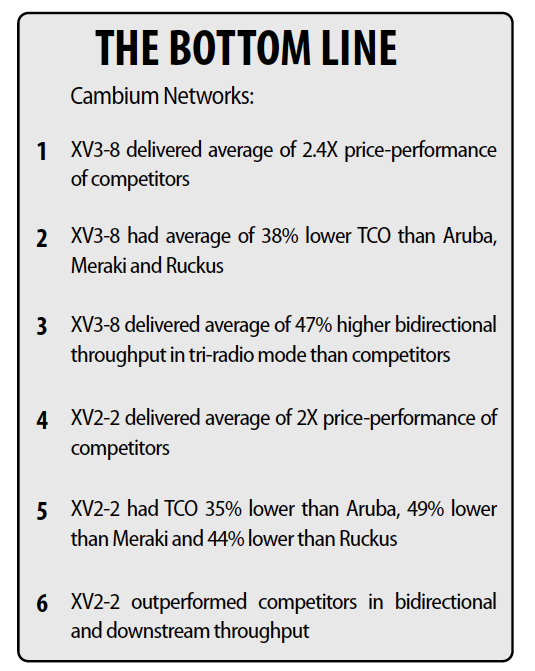
Wi-Fi 6 8×8/4×4 AP Max Throughput
Note to reader: The presentation of results in this blog is different from that in the Tolly report. Figure and tables are drawn from the full Tolly report and the references are to the report.
As the name implies, this test illustrates the max throughput for a given AP with traffic streaming bidirectionally and then unidirectionally both downstream and upstream. Cambium and Aruba can split the 8×8 radio into two 4x4s allowing a tri-radio operational mode. A quick look shows the potential benefits of the three-radio configuration. (Choice between tri- and dual-radios would be based on deployment particulars.) Cambium’s XV3-8 delivers the highest throughput in all scenarios. It is important to note that the Cambium downstream exceeds 2Gbps which leverages the higher speed uplink that Cambium provides.
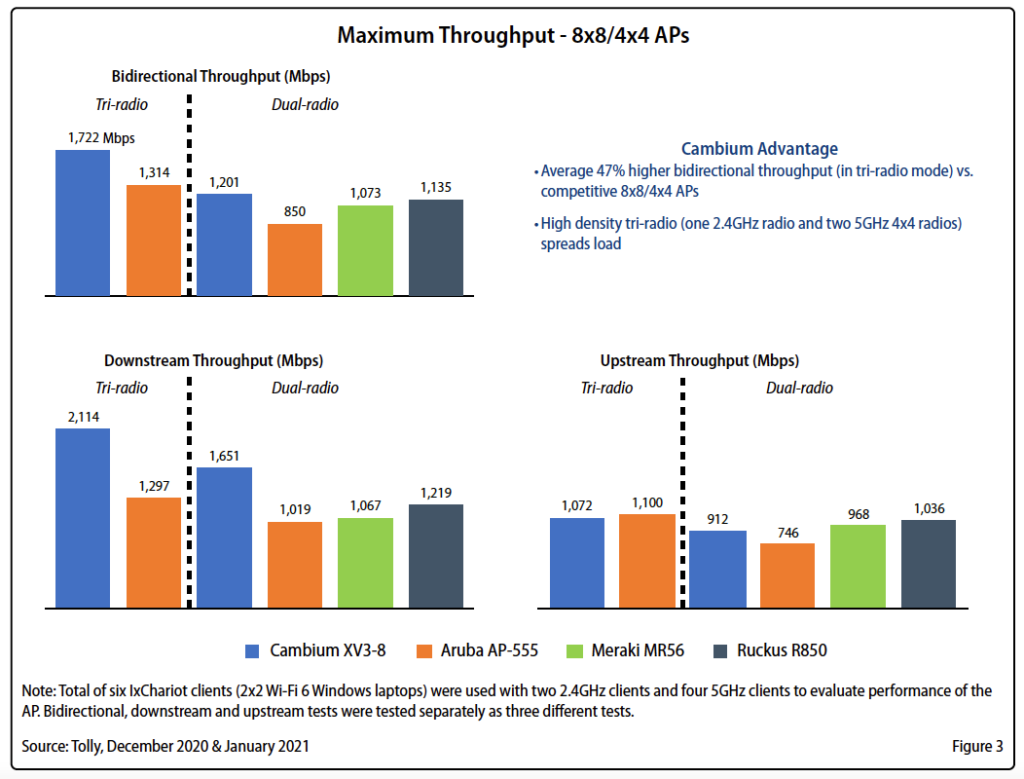
Wi-Fi 6 2×2 AP Max Throughput
The same test was run on the general purpose 2×2 APs.
The Cambium XV2-2 outperformed the others in both the bidirectional and downstream throughput tests. Most notably the Cambium XV2-2 can exceed 1Gbps of downstream throughput because the XV2-2 provides a 2.5GbE uplink where the other APs would have a maximum uplink throughput of 1Gbps per direction.
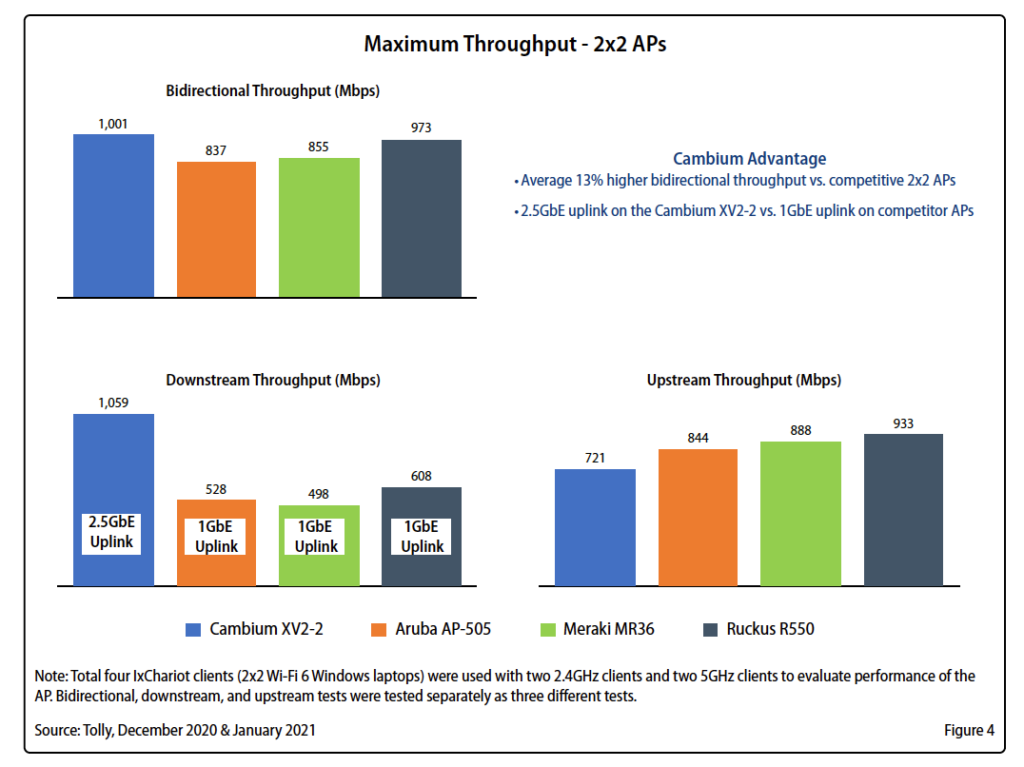
Wi-Fi 6 APs 5-Year TCO
Now that we have looked at throughput and seen solid results from the Cambium 8×8 and 2×2 offerings, a quick look at TCO is in order. Here we documented the list price of each offering plus five years of cloud management. Again, a quick glance shows the Cambium benefits in both the high-performance 8×8 and general-purpose 2×2 models.
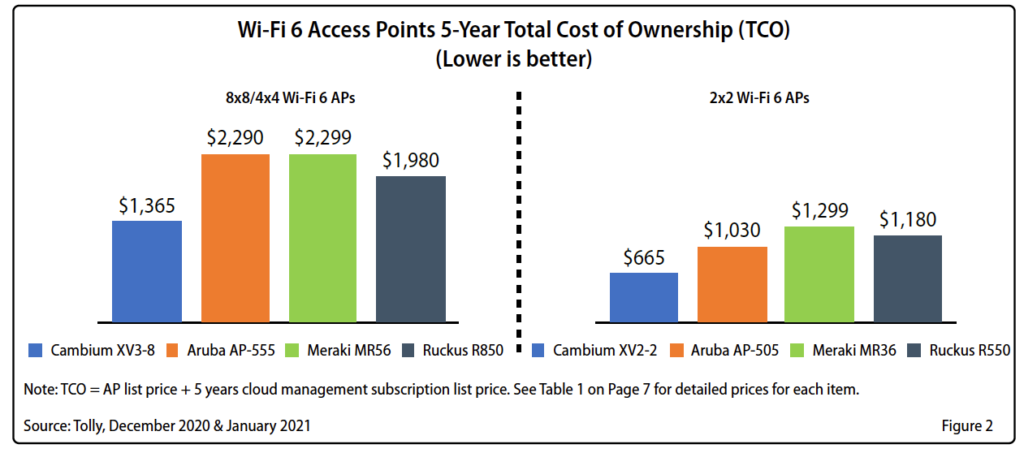
Wi-Fi 6 AP Pricing
As a point of reference, the table below shows the pricing and sources for the costs used in the price-related calculations.
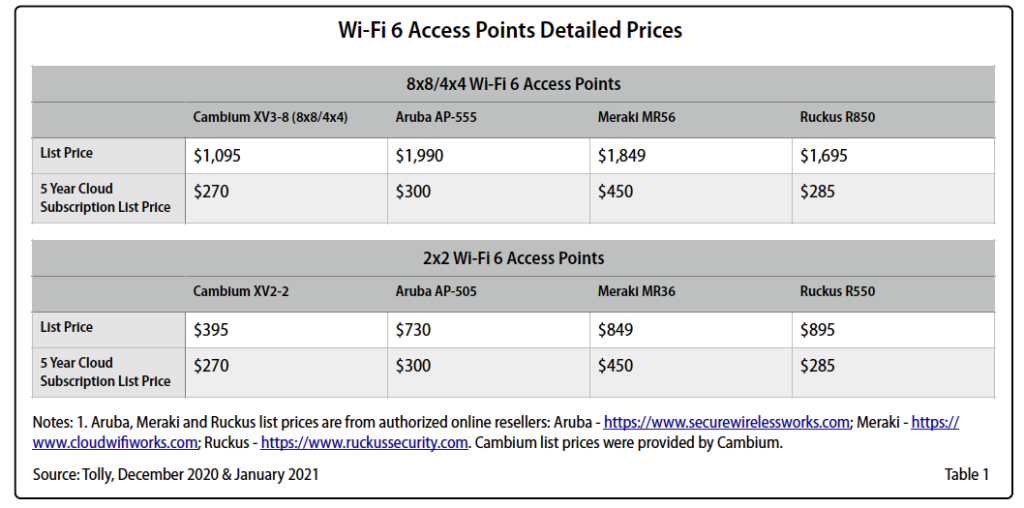
Wi-Fi 6 8×8/4×4 AP Price-Performance
In addition to TCO, price-performance is a useful way of calculating value. Here we use both the price and the throughput to calculate the cost of performance. That is, how many Mbps of throughput does one receive per dollar spent. Here, higher is better. This value was calculated using the bidirectional throughput numbers and the Cambium price-performance is more than twice that of the nearest competitors.
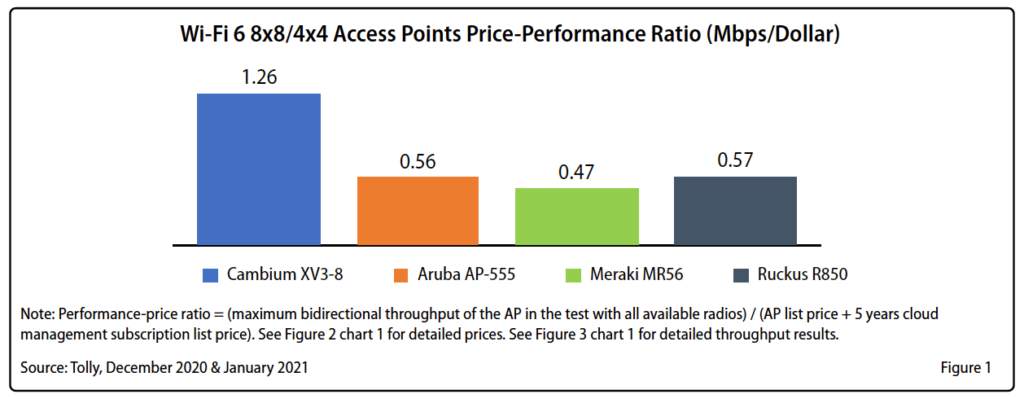
Wi-Fi 6 2×2 AP Price-Performance
The same calculation was done with the 2×2 APs and the relative price-performance relationship remains much the same. Here, too, the Cambium price-performance is close to twice that of the nearest competitors.
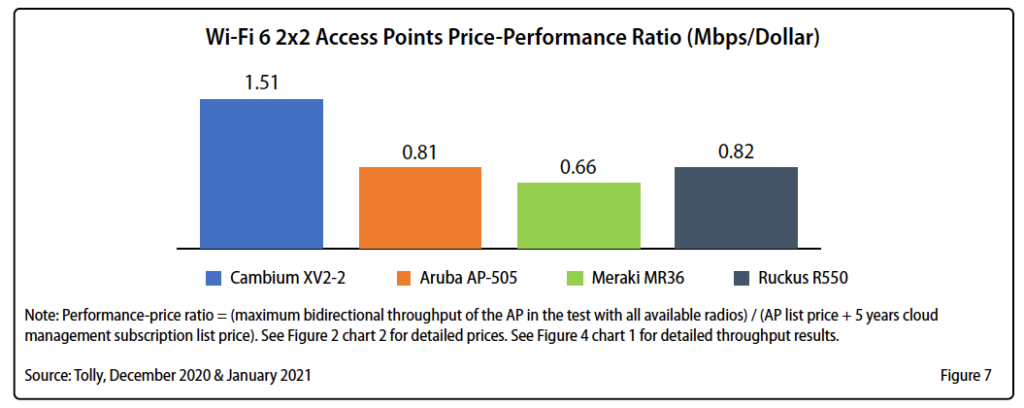
Wi-Fi 6 8×8/4×4 – High Density
As noted earlier, this test focused on testing in a multi-client, multi-device multi-OS, multi-Wi-Fi generation environment. See the Notes for details. 80% of the traffic was high bandwidth video and 20% was VoIP. The results can be looked at from two perspectives: total throughput and average voice quality. Note that for throughput and voice quality, higher is better but for latency and jitter, lower is better. Cambium delivered the highest results in total throughput along with good voice quality.
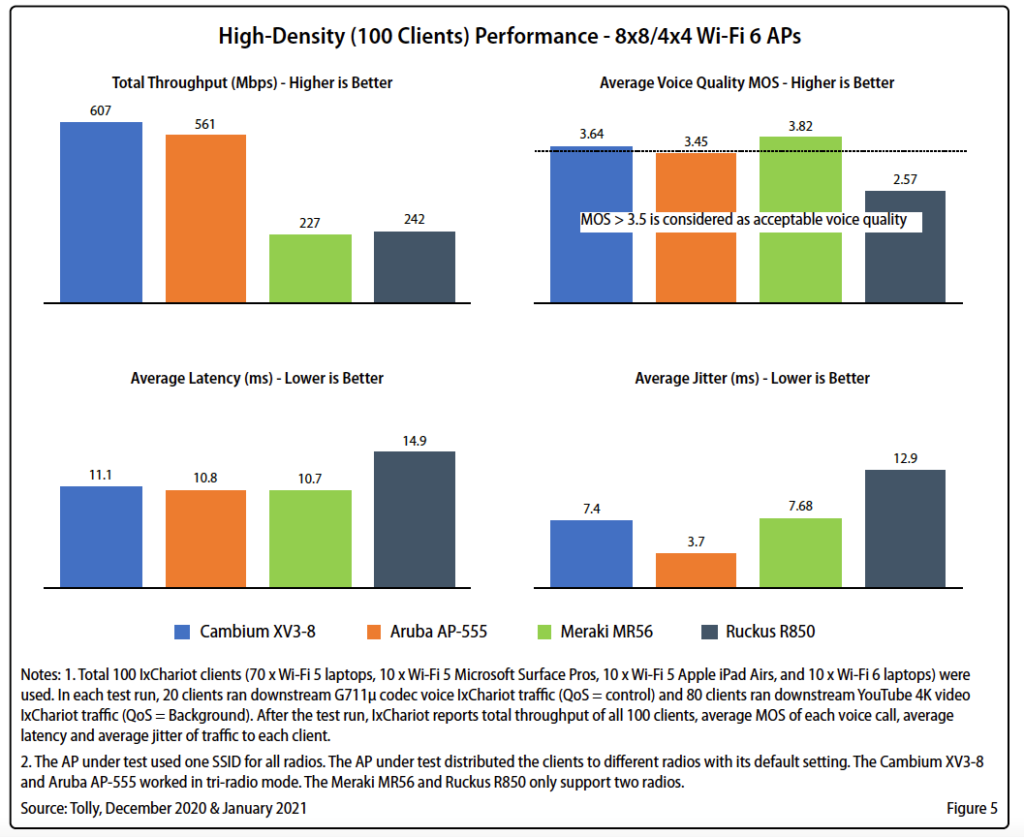
Wi-Fi 6 2×2 – High Density
Using 50 clients, an otherwise identical test was run using the 2×2 APs.
Cambiums XV2-2 throughput was second only to Meraki and delivered the best voice quality under load.
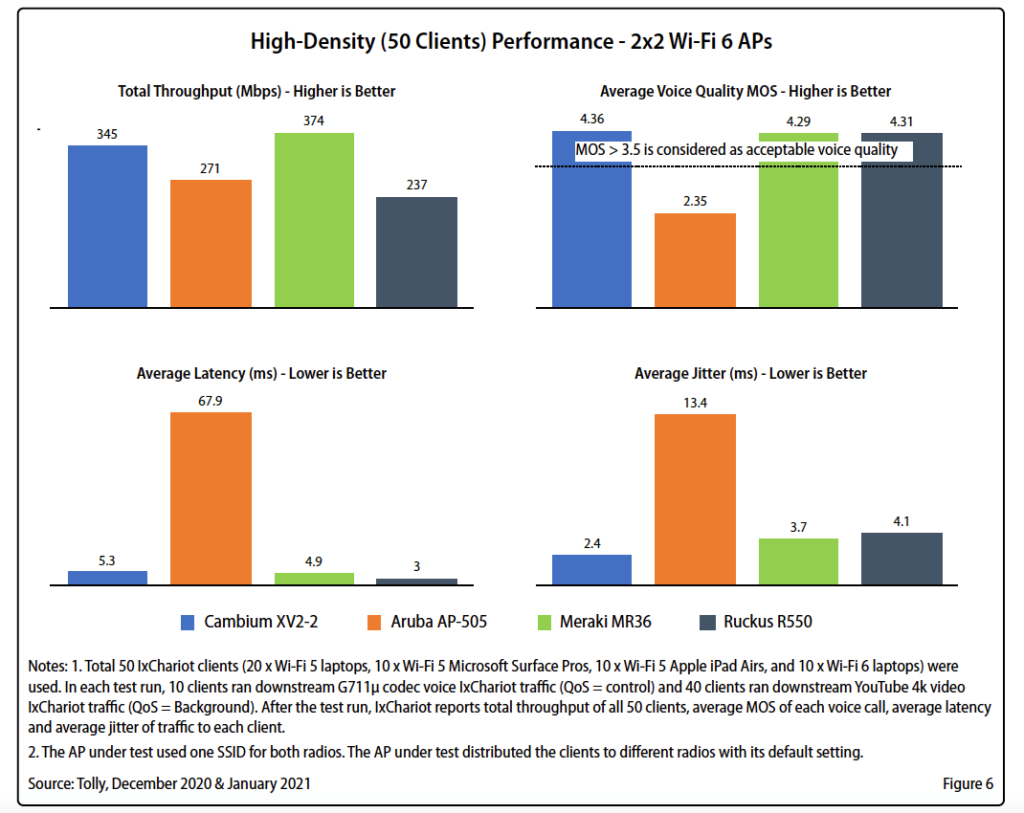
So, what does it all mean?
First off, multi-Gigabit Wi-Fi performance exists and is available today. Our test showed over 2Gbps bidirectional from a single AP. Don’t forget that if your AP provides only a single 1Gbps link then 1Gbps unidirectional throughput is the maximum you can ever achieve.
On higher capacity 8×8 APs, look for the option to split the 8×8 radio into two 4×4 radios as our testing showed quantifiable performance advantages.
When you look at overall performance, remember that you want good throughput and at the same time for latency-sensitive, high-priority applications like VoIP to perform well. So, include that in your test plan.
Finally, be sure to consider the pricing aspects of the solutions that you are considering. Building a basic TCO model and running some price-performance calculations can be done easily and can be quite eye-opening.
